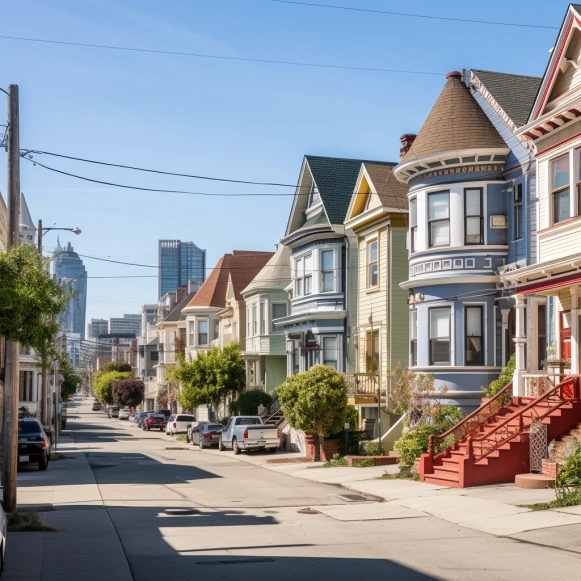Is historic preservation just another NIMBY tactic to avoid California housing laws?

Housing advocates say neighborhood groups across the Bay Area are using preservation rules to block density
Residents of San Mateo’s leafy Baywood neighborhood pleaded with the city to stop the demolition of a 1933 Spanish Revival home to make way for a much larger house with an attached in-law unit. But the Peninsula town’s options were limited. A California law passed in 2021 allowed the owner to build two units where previously only a single-family home was permitted.
For years, communities like Baywood, where the average home costs more than $2 million, took their lower-density character for granted. That has changed in recent years, as state lawmakers have passed legislation such as SB 9 to create more housing everywhere, particularly in areas previously zoned for single-family homes.
However, there is one notable exception to these state housing laws: historic properties.
The San Mateo Heritage Alliance applied to the California Office of Historic Preservation earlier this month to designate Baywood as a historic district, raising the ire of housing advocates.
“I don’t have a problem with historic districts — I have a problem with gaming historic preservation to try to evade state housing laws,” said state Sen. Scott Wiener, a sponsor of housing-development legislation. Wiener was a co-author of both SB 9 and SB 423, which streamlines the approval process for projects in cities that are falling behind on state-mandated housing goals.
Baywood is one of many California neighborhoods exploring historic designation in an effort to resist higher density in the face of new housing reform. The Miracle Mile Residential Association in Los Angeles, which fought SB 9, recently had its neighborhood designated as historic. Carthay, a little further west down Wilshire Boulevard, also received the designation. In response to housing activists’ protests last year, San Francisco’s St. Francis Wood neighborhood applied for and was granted historic district status.
The preservationists who are driving these movements claim that their neighborhoods have long been eligible for historic designation — but it takes either a city or a group of residents to submit an application. They argue that the Legislature exempted historic resources from these bills for a reason: to preserve the unique character of communities.
Historic status can be applied for at three different levels. Localities can enact their own historic preservation ordinances, which establish design standards for new construction, typically to match the existing building style. Neighbors can also nominate a site or district to the state or national register.
A property with historic status at any level is exempt from the streamlining bills. In other words, historic designation does not preclude new development; it simply means that a developer cannot develop by right, as new state laws allow, and must instead go through the approval process of the city.
“SB 9 included the historic exception,” said Mike Nash, who is married to San Mateo Deputy Mayor Lisa Diaz Nash and is an advocate for the Baywood historic district. “That was a decision made by the state government.” It’s not like they didn’t realize it, and it has had no effect on San Mateo’s ability to meet and exceed its housing targets in the future.”
In practice, however, preservation creates additional obstacles for developers to overcome. The new streamlining bills were put in place to avoid the types of lengthy reviews that cities can use to stall housing projects and have discouraged developers from pursuing projects in the Bay Area in the first place.
“This is a bad faith attempt to weaponize historic preservation in opposition to densifying and diversifying neighborhoods,” said Jordan Grimes, a San Mateo resident and leader of the pro-housing group Peninsula for Everyone.
It is not the first time that communities have used historic preservation to thwart change. Berkeley declared a parking lot a historic landmark in 2000 due to the possibility of a Native American shellmound beneath its surface, halting development of an apartment building. (An archeological study later funded by the developer discovered no evidence of a prehistoric refuse heap.) A developer in San Francisco was forced to spend thousands of dollars on a study of his laundromat after some neighbors declared it historic.
However, as California works to build the 2.5 million homes that housing officials estimate the state will need by 2031 to address the state’s housing shortage, communities must consider how much of the past should be preserved as the state plans for the future.
“It’s a matter of balancing those historic designations against other priorities and, most importantly, not abusing them,” said Matthew Lewis, communications director for California YIMBY, which assisted in lobbying for SB 9.
Historic designation criteria are broad and sometimes ambiguous — sites with a connection to a significant person, a historic event, or a specific architectural style are all eligible. Applications must defend a site’s eligibility in a lengthy study that is reviewed by the State Historical Resources Commission, and if national designation is desired, the application must be approved by a national office.
“We go through them with a fine-toothed comb,” Jay Correia, cultural resources program manager for California’s Office of Historic Preservation, said. Before an application reaches the commission, it may take months of back-and-forth between staff and applicants.
The San Mateo Heritage Alliance’s ongoing application for historic designation in Baywood has become a source of contention in the community. Although the group’s president, Laurie Hietter, claims that it has done “extensive outreach,” some critics see the effort as being led by a small group whose actions will affect what homeowners throughout the neighborhood can do with their properties.
“Most of the 350 homeowners have no idea this is happening,” San Mateo Mayor Amourence Lee, who opposes the proposal, said. “They didn’t ask for this.”
George Aviet understands what it’s like to be caught off guard by a historic designation.
In 2017, the owner of the Michelin-starred Chez TJ restaurant in downtown Mountain View applied to build a five-story building on the site of his restaurant. Aviet planned to relocate his historic 1894 building across the street and reopen the restaurant there.
Concerned that tall buildings had already ruined much of the city’s historic charm, Aviet’s neighbors petitioned to have the building listed on the California Register of Historic Resources. They conducted research that revealed the house was once owned by Julius Weilheimer, the city’s former mayor. They also argued for the addition of the neighboring building, which used to house a laundromat, to the historic register. Despite Aviet’s protests, the state commission approved both, effectively preventing Aviet from carrying out his plans.
“I’ve been here for 42 years, and I want this downtown to thrive,” Aviet said in a statement. “I want to see the city improve, but it’s not by restricting development like this.”
Not only are concerned neighbors stymieing the implementation of new housing reforms; many cities are also stymieing the implementation of new housing reforms through historic preservation. Only a few weeks after the legislature passed SB 9, Pasadena’s City Council passed an emergency ordinance establishing several “landmark districts” — or neighborhoods where 60% of the properties have “historical, cultural, development, and/or architectural context.” The city also planned to investigate the establishment of a citywide historic overlay district.
This sounded the alarm in the office of California Attorney General Rob Bonta, who has begun to step up enforcement of the state’s housing laws. His office claimed in a letter that Pasadena had violated state law “under the guise of protecting ‘landmark districts,'” which Pasadena Mayor Victor Gordo denied. (The city later changed its ordinance, gaining Bonta’s approval.)
Some cities are taking a more gradual approach. In the Bay Area, Palo Alto began updating its historic resources inventory in 2022, with the goal of adding specific buildings to a list of historic resources rather than designating an entire district. The 130 properties under consideration account for less than 1% of the city’s single-family homes.
There is also concern that historic districts will not be applied uniformly across the state.
“This becomes a fair housing issue where these wealthier, whiter communities are able to marshal the resources to put together a historic district and exempt themselves from state housing laws,” Wiener went on to say.
He believes the state should change the law to prevent historic preservation from providing a “blanket exemption” from state laws.
“Old buildings and new buildings can exist together,” Wiener went on to say.






